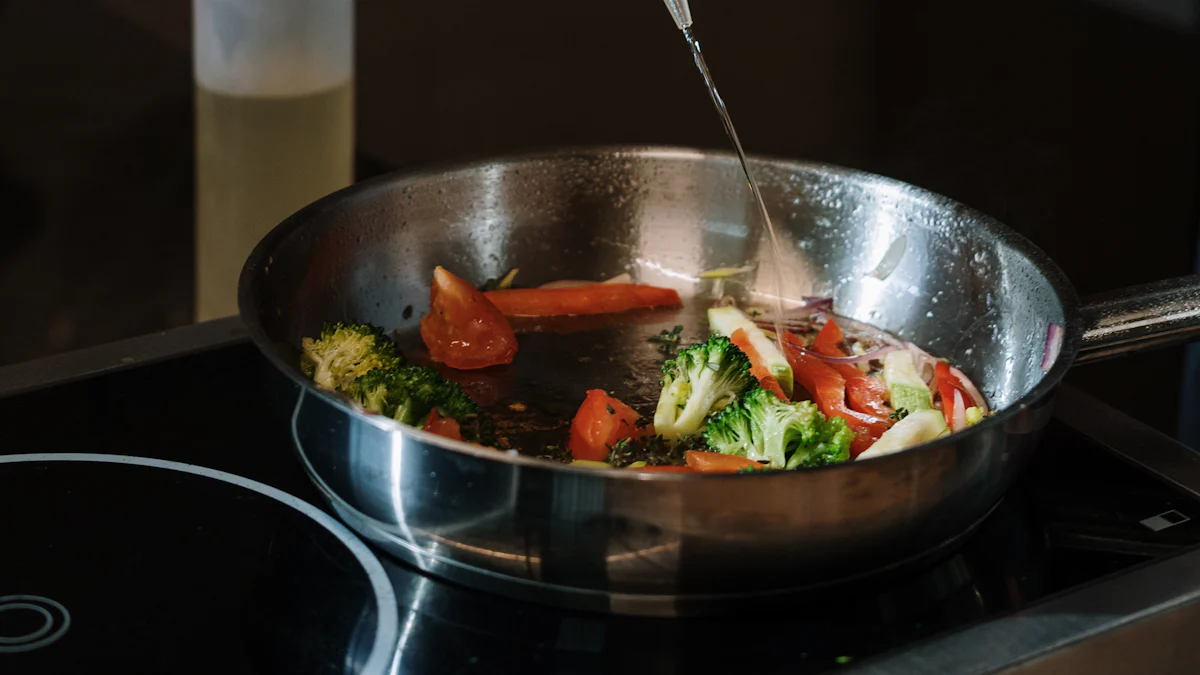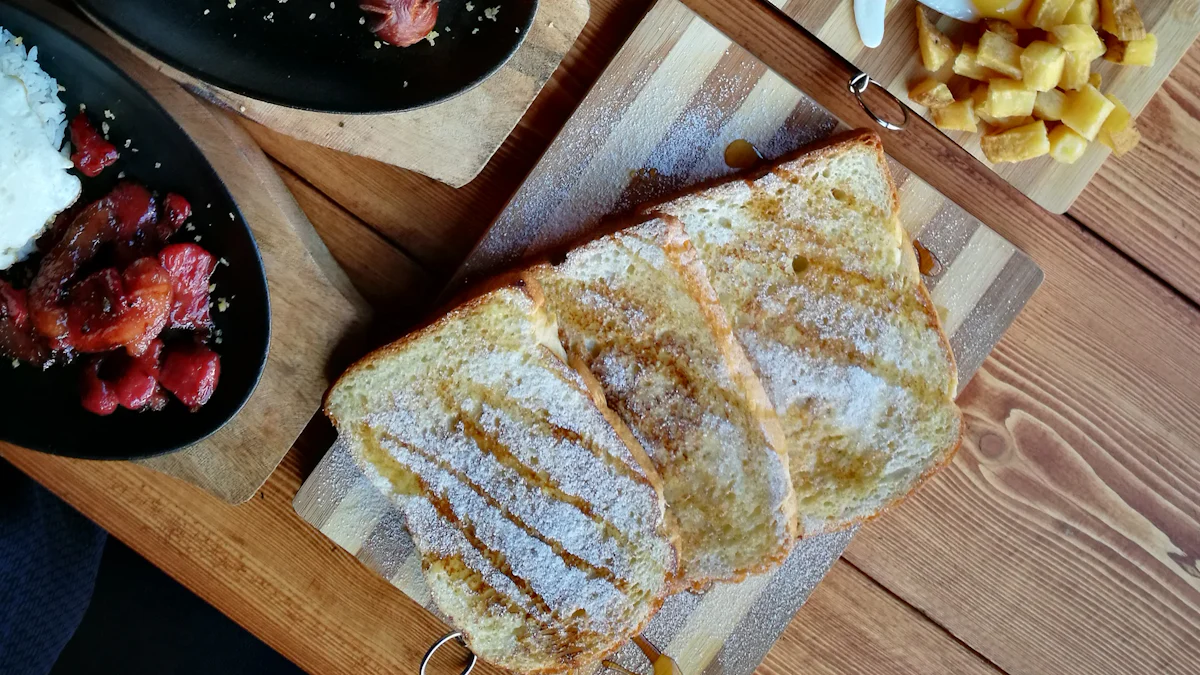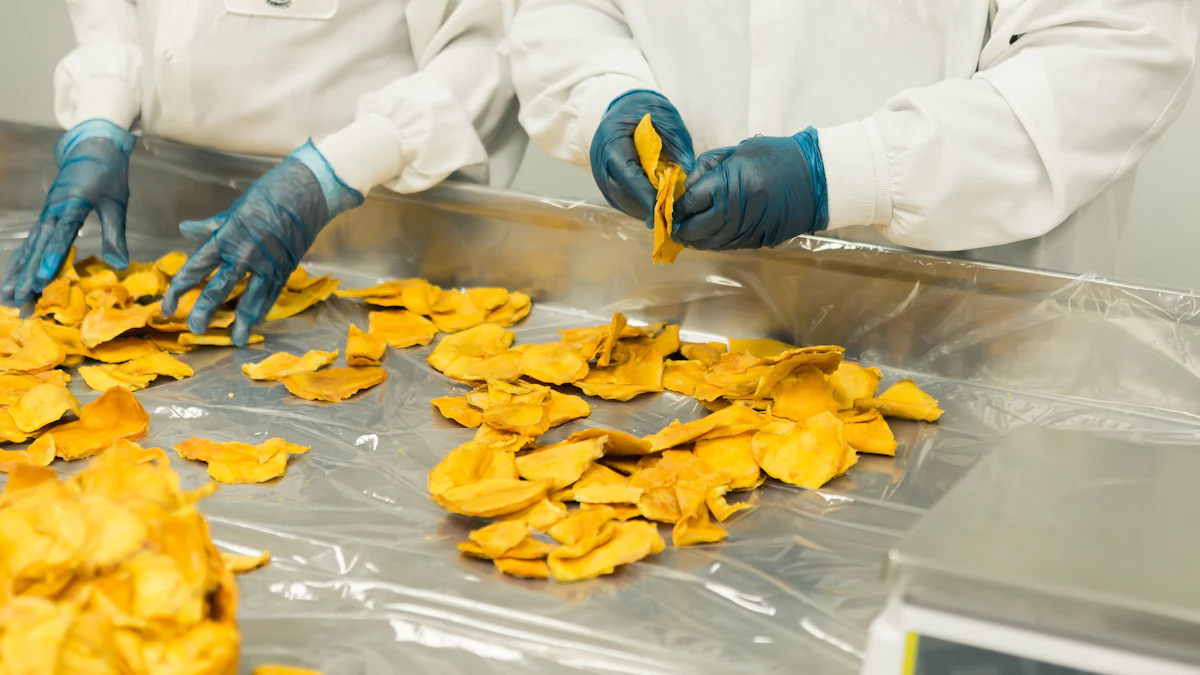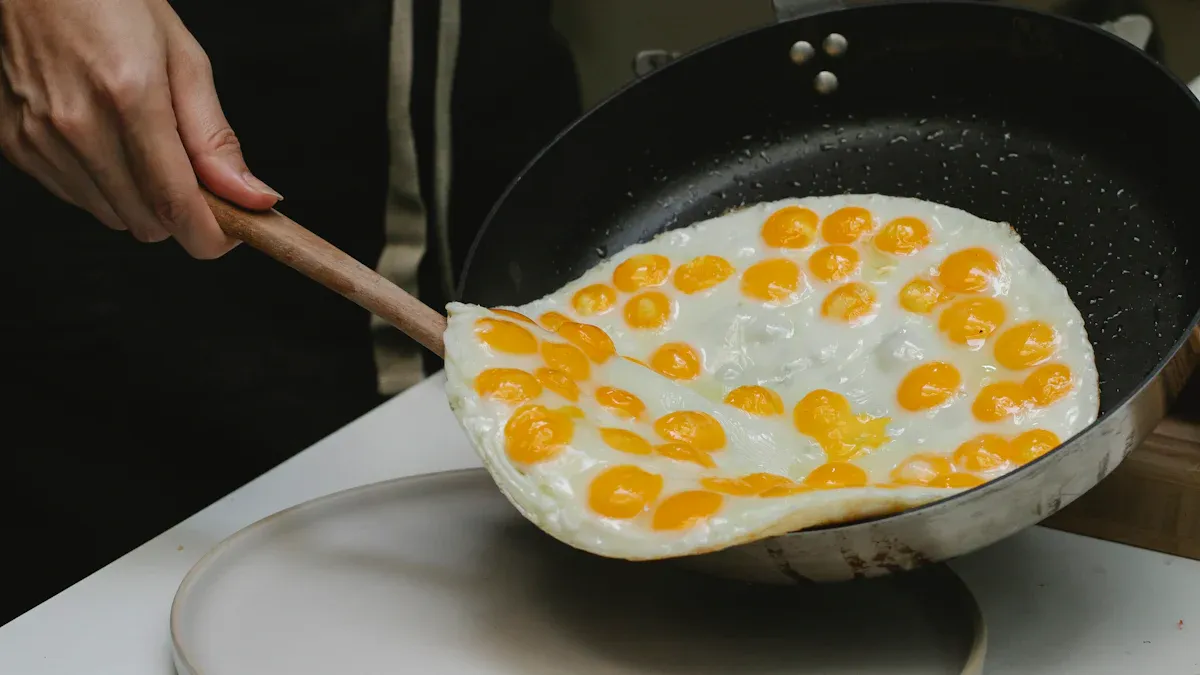
Electric multi-functional air fryers revolutionize cooking by providing an air fryer oven without oil, allowing you to enjoy delicious meals while retaining flavor. These devices utilize rapid air technology to achieve crisp, golden textures. According to a YouGov report, 34% of Americans use air fryers weekly, showcasing their popularity. Models such as the air fryer automatic large capacity and the air fryer oven with nonstick basket ensure easy cleanup and convenience.
How Does an Air Fryer Oven Without Oil Work?

Rapid Air Technology Explained
Air fryers rely on rapid air technology to cook food efficiently. This innovative method combines a heating element and a powerful fan to circulate hot air around the food. The heating element radiates heat downward, while the fan ensures the air moves rapidly and evenly. This process, known as convection heating, eliminates the need for oil while maintaining consistent cooking temperatures. The air-tight design of an air fryer oven without oil enhances this process by trapping heat and ensuring uniform distribution.
Tip: Rapid air technology not only cooks food faster but also promotes browning and flavor development through the Maillard reaction.
Circulating Hot Air for Even Cooking
Convection heating plays a crucial role in air fryers. The fan circulates hot air at high speeds, ensuring every part of the food receives consistent heat. Unlike traditional ovens, air fryers maintain a uniform temperature throughout the cooking chamber. This design prevents uneven cooking and ensures optimal results.
- Key principles of air circulation in air fryers:
- Hot air moves continuously around the food, ensuring uniform temperature.
- The fan acts as the primary heat source, cooking food quickly and evenly.
- The Maillard reaction enhances browning and flavor by exposing the food’s surface to hot air.
Achieving Crispiness Without Oil
Air fryers excel at creating crispy textures without the need for oil. The rapid circulation of hot air mimics the effect of deep frying by dehydrating the food’s outer layer. This process locks in moisture while forming a golden, crunchy exterior. Modern air fryers, such as those with nonstick baskets, further enhance crispiness by preventing food from sticking and ensuring even airflow.
| Feature | Description |
|---|---|
| Versatility and Consistency | Capable of cooking a wide variety of foods while maintaining consistent cooking temperatures. |
| Energy Efficiency Improvements | Incorporates energy-saving modes and improved insulation to reduce power consumption. |
An air fryer oven without oil offers a healthier alternative to traditional frying methods while delivering the same satisfying crunch and flavor.
The Science of Flavor Retention in Air Fryers
Understanding the Maillard Reaction
The Maillard reaction plays a pivotal role in flavor development during cooking. This chemical process occurs when heat interacts with amino acids and reducing sugars on the surface of food. It produces complex flavor compounds and a golden-brown color. Foods like bread crusts, roasted meats, and fried potatoes owe their rich taste to this reaction. Air fryers create the ideal environment for the Maillard reaction by maintaining high temperatures and circulating hot air. This ensures that food develops a flavorful crust without requiring oil.
Note: The Maillard reaction begins at temperatures above 285°F (140°C). Air fryers are designed to reach and sustain these temperatures efficiently.
How Air Fryers Enhance Flavor Without Oil
Air fryers enhance flavor by focusing on heat distribution and moisture retention. The rapid air circulation dehydrates the food’s surface, creating a crispy texture while locking in natural juices. This method eliminates the need for oil, which often masks the food’s inherent flavors. Instead, the air fryer oven without oil allows the natural taste of ingredients to shine through. Additionally, the controlled cooking environment prevents overcooking, preserving the food’s original flavor profile.
The Role of Heat and Air Circulation in Browning
Heat and air circulation are essential for achieving the perfect browning in air fryers. The heating element generates consistent high temperatures, while the fan ensures even airflow around the food. This combination promotes uniform browning, a key factor in flavor retention. Unlike traditional frying, which relies on oil as a heat conductor, air fryers use hot air to achieve similar results. The absence of oil reduces the risk of sogginess, ensuring a crisp and flavorful exterior.
Tip: Preheating the air fryer can improve browning by ensuring the cooking chamber reaches the desired temperature before food is added.
Comparing Air Frying to Traditional Frying

Key Differences in Cooking Methods
Air frying and traditional frying differ significantly in their cooking processes. Air fryers rely on rapid air circulation to cook food, while deep fryers submerge food in hot oil. This distinction impacts both the cooking environment and the final product.
Unlike traditional deep frying, air frying involves the addition of only a few tablespoons of oil to coat the food before cooking, or in many cases, does not require adding oil at all. Achieving a crunchy, golden-brown crust that shatters between your teeth is essentially a process of dehydration. When food is submerged into hot oil, heat from the oil diffuses into the uncooked food, gradually cooking it.
Air frying also emphasizes water evaporation to create steam, which surrounds the food and aids in cooking. This dry cooking method resembles roasting or baking more than frying.
Oil Usage and Its Effect on Flavor
The amount of oil used in cooking greatly influences flavor. Deep frying relies on oil as the primary cooking medium, which imparts a rich, fatty taste to food. In contrast, air fryers use little to no oil, allowing the natural flavors of ingredients to shine.
The main difference between an air fryer and a deep fryer is the amount of oil used for cooking. Deep fryers heat oil or fat to high temperatures to cook while air fryers cook food with rapidly circulated hot air and little to no oil.
An air fryer oven without oil provides a healthier alternative by reducing the calorie content of meals without sacrificing flavor.
Texture and Taste: Air Fryers vs. Deep Fryers
Foods cooked in air fryers often lack the thick, crispy crust associated with deep frying. This difference becomes more noticeable with liquid batters or moist foods, as air fryers struggle to set these properly. Deep fryers excel in creating a traditional fried texture, especially for battered items.
However, air fryers still deliver satisfying results for many foods. For example, chicken wings cooked in an air fryer develop a crispy exterior while retaining their juiciness. Cooking times also vary, with air fryers often requiring less time for certain dishes.
| FOOD | AIR-FRYER TIME |
|---|---|
| Bacon | 5-10 minutes |
| Chicken Breast | 22-23 minutes |
| Salmon | 5-7 minutes |
| Fries | 10-20 minutes |
While deep fryers may offer a slight edge in texture, air fryers provide a healthier and more efficient cooking option for everyday meals.
Health and Practical Benefits of Using an Air Fryer Oven Without Oil
Lower Fat and Calorie Content
Air fryers offer a healthier alternative to traditional frying by significantly reducing fat and calorie intake. Unlike deep fryers, which require multiple cups of oil, air fryers use only a tablespoon or none at all. This reduction can lower calorie consumption by up to 80%, making it an excellent choice for those managing their weight. Additionally, air frying minimizes the formation of acrylamide, a harmful chemical linked to cancer risk, by up to 90%. Lower oil usage also reduces the risk of heart disease and inflammation, contributing to long-term health benefits.
Tip: Switching to air frying can help preserve nutrients in food better than traditional frying methods, ensuring meals are both healthy and flavorful.
Convenience and Ease of Use
Air fryers simplify cooking with user-friendly features and safety mechanisms. Many models include intuitive digital controls, automatic shut-off systems, and overheating protection. Cool-touch handles enhance safety, making air fryers suitable for households with children. These devices also eliminate the mess associated with deep frying, as they do not involve large quantities of oil. Cleaning becomes effortless with nonstick baskets and dishwasher-safe components.
Note: The compact design of air fryers allows them to fit seamlessly into any kitchen, saving space while offering versatility for various recipes.
Eco-Friendly and Versatile Cooking
Air fryers contribute to eco-friendly cooking by producing minimal indoor air pollutants. Compared to traditional methods, air fryers emit significantly lower levels of particulate matter (0.6 µg/m³) and volatile organic compounds (20 ppb). This reduction helps improve indoor air quality and reduces the risk of respiratory issues. Furthermore, air fryers consume less energy than conventional ovens, making them an environmentally conscious choice. Their versatility allows users to prepare a wide range of dishes, from crispy fries to roasted vegetables, without compromising sustainability.
| Cooking Method | Particulate Matter (µg/m³) | VOCs (ppb) |
|---|---|---|
| Air Fryers | 0.6 | 20 |
| Traditional Methods | Higher | Higher |
Tip: Using an air fryer oven without oil not only promotes healthier eating but also supports a greener lifestyle by reducing environmental impact.
Tips for Enhancing Flavor in Oil-Free Air Frying
Mastering Seasoning Techniques
Seasoning plays a vital role in enhancing the flavor of foods cooked in an air fryer. Dry seasonings, such as paprika, garlic powder, and black pepper, adhere well to food surfaces and develop rich flavors during cooking. To ensure even seasoning, users should toss ingredients in a bowl before placing them in the air fryer. Avoid adding salt too early, as it can draw out moisture and hinder crispiness. Instead, sprinkle salt after cooking for optimal results.
Tip: Lightly coat food with a small amount of oil spray to help seasonings stick better and intensify their flavor during cooking.
Preheating and Temperature Control
Preheating an air fryer ensures consistent cooking and enhances flavor retention. Foods like burgers, chicken nuggets, and french fries benefit from preheating, as it creates a crispier texture and promotes even browning.
- Benefits of preheating:
- Speeds up cooking time.
- Improves searing and charring.
- Enhances crispiness for foods requiring a crunchy exterior.
Maintaining proper temperature control is equally important. Overcrowding the basket can lead to uneven cooking, leaving some areas undercooked. Users should cook in smaller batches to achieve uniform results.
Using Marinades and Dry Rubs for Better Taste
Marinades and dry rubs elevate the flavor of oil-free dishes by infusing ingredients with bold, aromatic profiles. Acidic marinades, containing lemon juice or vinegar, tenderize proteins while adding tangy notes. Dry rubs, made from a blend of spices, create a flavorful crust when exposed to the hot air circulation of an air fryer oven without oil. For best results, allow food to marinate for at least 30 minutes before cooking.
Note: Avoid using excessive liquid marinades, as they can drip and cause smoke or sogginess during cooking.
Electric air fryers offer a healthier way to cook by eliminating the need for oil while retaining flavor through rapid air technology and the Maillard reaction. Their versatility shines in recipes like crispy tofu stir-fry, lemon-pepper shrimp, and air-fried banana bread. An air fryer oven without oil simplifies cooking, making it an ideal choice for health-conscious individuals.
Tip: Experimenting with air fryer recipes can transform everyday meals into guilt-free culinary delights.
FAQ
What types of food can be cooked in an air fryer?
Air fryers can cook a variety of foods, including vegetables, meats, seafood, and baked goods. Popular options include fries, chicken wings, roasted vegetables, and even desserts.
Do air fryers require preheating before cooking?
Preheating is recommended for optimal results. It ensures even cooking and enhances crispiness. Most air fryers preheat within 3-5 minutes, depending on the model.
Tip: Always check your air fryer’s manual for specific preheating instructions.
How do air fryers compare to ovens in terms of energy efficiency?
Air fryers consume less energy than conventional ovens due to their compact size and faster cooking times. They are an eco-friendly choice for energy-conscious households.
Note: Using an air fryer can reduce cooking time by up to 25%, saving both energy and time.





